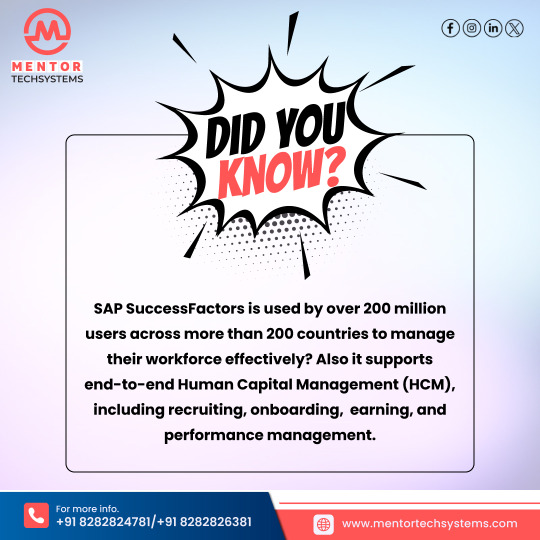#successfactors
Explore tagged Tumblr posts
Text
Aligning Employee Performance with Organizational Strategy: The Power of Balanced Scorecard
In today’s fast-paced and ever-evolving business environment, organizations face constant pressure to achieve their strategic objectives while maintaining a competitive edge. A major determinant of success lies in the ability to align employee performance with organizational goals. This alignment ensures that every action taken by employees contributes meaningfully to the broader objectives of the company. One of the most effective tools for achieving this alignment is the Balanced Scorecard (BSC).
The Balanced Scorecard, introduced by Robert Kaplan and David Norton in the early 1990s, is a performance management framework that translates an organization's vision and strategy into a coherent set of performance measures. Unlike traditional performance metrics that focus solely on financial outcomes, the BSC takes a holistic view by incorporating non-financial perspectives. This article explores how the BSC can be a powerful tool for aligning employee performance with organizational strategy and driving continuous improvement.
Understanding the Balanced Scorecard
The Balanced Scorecard consists of four perspectives that provide a comprehensive view of organizational performance:
Financial Perspective: This focuses on the financial objectives of the organization, such as revenue growth, profitability, and cost management. It answers the question: How do we look to our shareholders?
Customer Perspective: This perspective emphasizes customer satisfaction, retention, and acquisition. It answers the question: How do customers perceive us?
Internal Processes Perspective: This perspective examines the efficiency and effectiveness of internal business processes. It answers the question: What must we excel at?
Learning and Growth Perspective: This focuses on the organization’s ability to innovate, improve, and learn. It answers the question: How can we continue to improve and create value?
Each of these perspectives is interconnected, creating a balanced approach to performance management that goes beyond short-term financial metrics.
The Need for Alignment
For an organization to achieve its strategic objectives, alignment across all levels—from top management to front-line employees—is essential. Misalignment can lead to inefficiencies, wasted resources, and disengaged employees who lack clarity on how their work contributes to the company’s goals.
The Balanced Scorecard provides a structured framework to:
Clarify Strategic Objectives: By breaking down high-level goals into specific, measurable objectives, the BSC ensures that employees understand the company’s priorities.
Communicate Expectations: The BSC enables organizations to communicate what success looks like across all levels, reducing ambiguity and fostering a sense of purpose.
Link Individual Goals to Strategy: The BSC helps translate organizational goals into individual performance metrics, ensuring every employee’s efforts are aligned with the overall strategy.
How the BSC Aligns Employee Performance with Organizational Strategy
1. Cascading Goals Through the Organization
The Balanced Scorecard promotes a cascade effect, where high-level strategic goals are translated into departmental, team, and individual objectives. For instance:
At the organizational level, a strategic objective might be to "increase market share by 10%."
At the departmental level, the sales team’s objective might be to "acquire 500 new customers this quarter."
At the individual level, a sales representative’s objective might be to "close 50 new customer deals per month."
This cascading approach ensures that every employee’s goals are directly tied to the organization’s strategy, creating a clear line of sight between individual performance and organizational success.
2. Defining Key Performance Indicators (KPIs)
The BSC emphasizes the use of Key Performance Indicators (KPIs) to measure progress against strategic objectives. These KPIs provide employees with clear targets and benchmarks, enabling them to understand how their performance contributes to the organization’s goals. For example:
Financial Perspective: Reduce operating costs by 15%.
Customer Perspective: Achieve a Net Promoter Score (NPS) of 85.
Internal Processes Perspective: Reduce order processing time by 20%.
Learning and Growth Perspective: Increase employee training hours by 30%.
By linking these KPIs to individual roles, employees can see the tangible impact of their work.
3. Enhancing Employee Engagement
When employees understand how their roles align with organizational strategy, they are more likely to feel engaged and motivated. The BSC fosters this alignment by:
Providing clarity on expectations.
Offering a sense of purpose by showing how individual contributions drive organizational success.
Enabling meaningful conversations between managers and employees about performance and development.
Engaged employees are not only more productive but also more likely to contribute innovative ideas and take ownership of their work.
4. Driving Continuous Improvement
The Balanced Scorecard is not a one-time exercise; it is a dynamic tool that encourages continuous feedback and improvement. By regularly reviewing performance metrics, organizations can identify areas for improvement and adjust strategies as needed. For employees, this continuous feedback loop fosters a culture of learning and adaptability.
For example, if a team is struggling to meet its KPIs in the internal processes perspective, management can analyze the root causes and implement corrective actions, such as additional training or process reengineering.
5. Fostering Accountability
The BSC promotes accountability by clearly defining roles, responsibilities, and performance expectations. Employees are held accountable for their contributions, while managers are responsible for providing the necessary support and resources. This accountability ensures that everyone is working towards the same objectives.
Implementing the Balanced Scorecard
To effectively implement the Balanced Scorecard, organizations should follow these steps:
Define Strategic Objectives: Start by identifying the organization’s vision, mission, and strategic goals.
Develop the Scorecard: Create a Balanced Scorecard that includes objectives, KPIs, and targets for each perspective.
Communicate the Strategy: Ensure that all employees understand the organization’s strategy and how it relates to their roles.
Cascade Objectives: Translate high-level goals into departmental and individual objectives.
Monitor and Review Performance: Regularly track progress against KPIs and provide feedback to employees.
Adapt and Improve: Use insights from performance reviews to refine strategies and processes.
Conclusion
The Balanced Scorecard is a powerful tool for aligning employee performance with organizational strategy. By providing a clear framework for translating high-level goals into actionable objectives, the BSC ensures that all employee’s efforts contribute meaningfully to the organization’s success. Furthermore, its emphasis on continuous improvement fosters a culture of learning, accountability, and engagement.
In an era where agility and alignment are critical for success, the Balanced Scorecard offers organizations a proven methodology for driving performance and achieving strategic goals. By leveraging this framework, companies can unlock the full potential of their workforce and achieve sustainable growth. Sachin Pilaniwala Director at Vynso Business Services LLP
#technology#tectalik#datadriven#cloudcomputing#erp#HRMS#businessintelligence#artificialintelligence#BusinessGrowth#successfactors#SuccessJourney#retail#jewellery#restaurant#business#DigitalTransformation#TransformingBusinesses#starr#smaart#software#performance#performancemanagement#PerformanceManagementSystem#KPI#PerformanceManagement#TeamSuccess#Productivity#TheoryOfConstraints#Goldratt#BalancedScorecard
0 notes
Text
Taxi Booking App Development - SpotnRides

Are you curious about what makes a taxi booking application stand out in today’s competitive market? Dive into our latest blog post where we analyze the top factors that contribute to the success of these apps. From user-friendly interfaces to robust security features, we cover it all!
Read more here: https://www.spotnrides.com/blog/analyzing-the-top-factors-behind-a-successful-taxi-booking-application/
WhatsApp: https://wa.me/917094344705
#uberclone#TaxiApp#RideHailing#AppDevelopment#TechTrends#MobileApps#StartupTips#UserExperience#UXDesign#TaxiBooking#SuccessFactors#DigitalTransformation#BusinessGrowth#Entrepreneurship#TechInnovation#SmartTransportation#CustomerSatisfaction#AppSuccess#MarketAnalysis#SoftwareDevelopment#BusinessStrategy#TravelTech#Innovation#OnDemandServices#SpotnRides#BlogPost
0 notes
Text
The Strategic Partner: Redefining the Role of HRM in Organizational Success
The Strategic Partner in Human Resource Management (HRM) refers to the evolving role of HR professionals as integral contributors to an organization's overall strategy and success. This concept signifies a departure from traditional views of HR as merely an administrative function focused on compliance and personnel management. Instead, HR is seen as a vital ally in achieving business goals and driving organizational performance.

The field of Human Resource Management (HRM) has experienced a profound evolution, shifting from a traditional administrative function to a strategic partner that actively contributes to organizational success. Once primarily focused on compliance and employee relations, HRM has transformed into a key player in driving business objectives, supporting innovation, and fostering sustainable growth. This essay explores the critical characteristics of HRM as a strategic partner, the tangible benefits it brings to organizations, and real-world examples that illustrate HR’s role in transforming business landscapes.
Key Characteristics of a Strategic HR Partner
To fulfill its role as a strategic partner, HRM has embraced several key characteristics that align it closely with core business strategies, including:
Aligning HR Strategies with Business Objectives A strategic HR partner integrates HR goals with the broader goals of the organization, ensuring that human capital strategies actively contribute to long-term objectives. This alignment allows HR to proactively support business growth by recruiting, developing, and retaining the right talent to drive success. For instance, HR can help identify future skills essential to business expansion and design training programs to develop those skills within the workforce.
Fostering a Culture of Innovation and Collaboration Strategic HRM actively promotes a workplace culture that encourages creativity, risk-taking, and teamwork. By developing programs that support cross-functional collaboration and recognizing employee contributions, HR can cultivate an innovative environment that adapts to change and fosters continuous improvement.
Developing and Implementing Data-Driven HR Initiatives The modern HR function relies on data and analytics to make informed decisions. By tracking metrics such as employee engagement, turnover rates, and performance data, HRM can identify trends, address potential challenges, and evaluate the impact of HR strategies. These insights allow HR to adjust practices based on evidence, increasing their effectiveness and ensuring HR initiatives contribute to organizational goals.
Providing Expert Guidance on Talent Management and Development A strategic HR partner invests in talent management as a core function, encompassing recruitment, development, performance management, and succession planning. This approach ensures that the organization has a robust pipeline of skilled employees ready to fill critical roles, minimizing disruptions and enabling sustainable growth.
Driving Organizational Change and Transformation In today’s fast-paced business environment, organizations must continually evolve to stay competitive. Strategic HRM plays a vital role in change management by leading initiatives that prepare the workforce for transitions, such as digital transformation, restructuring, or cultural shifts. By facilitating communication and training during periods of change, HR helps employees adapt smoothly, ensuring that transformation efforts are successful and aligned with business goals.
Benefits of a Strategic HR Partner
The shift to a strategic HRM model brings a range of advantages that impact both organizational performance and employee satisfaction. Key benefits include:
Enhanced Business Outcomes Through Aligned HR Strategies By aligning HR strategies with business goals, HRM contributes directly to improved organizational performance. When HR initiatives support core objectives, the organization can optimize workforce productivity, reduce turnover, and achieve financial targets more effectively.
Improved Employee Engagement and Retention Engaged employees are more likely to stay with the company and contribute positively to its success. Strategic HRM enhances engagement by implementing programs that support employee well-being, recognize achievements, and provide career development opportunities. High engagement leads to lower turnover, saving costs related to recruiting and onboarding and retaining valuable institutional knowledge.
Increased Innovation and Competitiveness Organizations with a strategic HRM approach are better positioned to foster innovation. HRM initiatives such as talent development, cross-functional teams, and continuous learning create an environment where employees feel empowered to generate new ideas. This culture of innovation helps organizations respond to market changes quickly and maintain a competitive edge.
Better Decision-Making Through Data-Driven Insights The use of HR analytics allows for evidence-based decisions in areas such as hiring, employee development, and retention. This data-driven approach enables HR to predict workforce needs, tailor engagement initiatives, and track the effectiveness of various programs, allowing for agile and precise responses to evolving organizational needs.
Effective Talent Management and Development As a strategic partner, HRM helps organizations manage talent proactively. By focusing on development and succession planning, HR ensures that employees are prepared to take on new responsibilities as the business grows. Effective talent management improves continuity, reduces the need for external hiring, and allows for greater adaptability within the workforce.
Case Studies
The transformation of HR into a strategic partner is evident in several leading companies that have leveraged HRM to achieve substantial organizational change and growth:
IBM's HR Transformation into a Strategic Partner IBM has long been a leader in integrating HR with strategic goals. In recent years, the company has utilized data analytics to understand workforce trends and drive key decisions related to employee engagement, retention, and talent acquisition. By embedding HR in the decision-making process, IBM’s HR department has become an essential partner in fostering innovation and guiding the company through periods of transformation.
Google's Innovative Approach to HR and Talent Management Google is renowned for its forward-thinking HR practices, which focus on attracting top talent, fostering a collaborative culture, and providing employees with the resources to succeed. Google’s People Operations team uses data-driven insights to refine hiring practices, increase engagement, and support employee well-being. This strategic approach has allowed Google to maintain a competitive edge by nurturing a highly motivated and innovative workforce.
The Role of HR in Driving Cultural Change at Microsoft Microsoft’s recent cultural transformation was heavily influenced by its HR team. Under CEO Satya Nadella’s leadership, Microsoft shifted from a “know-it-all” to a “learn-it-all” culture, with HR playing a key role in fostering openness, adaptability, and continuous learning. This cultural shift helped Microsoft attract new talent, enhance collaboration, and drive innovation, allowing the company to re-establish itself as a technology leader.
Conclusion
The evolution of HRM from an administrative role to a strategic partner marks a paradigm shift in how organizations view the value of human capital. By aligning HR strategies with business objectives, fostering innovation, and providing guidance on talent management, HRM has proven to be essential in achieving organizational success. Case studies from companies such as IBM, Google, and Microsoft demonstrate the tangible impact that a strategic HR approach can have on culture, productivity, and competitive advantage. As the business landscape continues to evolve, HRM’s role as a strategic partner will only become more crucial in helping organizations adapt, grow, and thrive. In the future, HR will be indispensable in driving sustainable growth, innovation, and success by ensuring that human capital remains a key asset in achieving organizational goals.
#HRReimagined#FutureOfWork#DigitalHR#HRInnovation#PeopleManagement#CultureTransformation#BusinessGrowth#StrategicPlanning#HRLeadership#OrganizationalDesign#TalentDevelopment#SuccessFactors#HRMetrics#Analytics#InsightfulHR
0 notes
Text

🌍 Did you know? SAP SuccessFactors is trusted by over 200 million users in 200+ countries to streamline workforce management! From recruiting to performance management, it covers all aspects of Human Capital Management.
For more info,
contact us at 📞 +91 8282824781 or +91 8282826381!
Visit us 👉 www.mentortechsystems.com
#HRManagement#SuccessFactors#MentorTechSystems#sap#sapinsituteinpune#SAPSuccessFactors#sapjob#sapcareer#SAPTraining
0 notes
Text
All enterprises small, medium, or big have changed to & are still shifting to SAP Services and the trend does not seem to stop going forward. The industry has gained momentum in the last few years and major players in the game like Ingenx Technologies are coming up with new products and services to cater to businesses that need it.
#Employee Central#Enterprise Asset Management#SAP Services#SAP Success Factors#Success Factors#SuccessFactors
0 notes
Text
The Art of Building Emotional Connections in a Digital World

In today's interconnected world, the way we engage with brands has transcended traditional boundaries. Beyond mere transactions, modern consumers seek meaningful interactions that resonate emotionally. This shift has propelled digital innovation to the forefront, transforming how businesses connect with their audiences on a profound level.
In the realm of digital marketing, fostering emotional connections has become a cornerstone of building lasting customer loyalty and advocacy. From personalized AI-driven experiences to immersive storytelling and interactive content, brands are leveraging technology to evoke emotions and create memorable engagements.
This blog explores the dynamic intersection of digital innovation and emotional connections. We delve into the importance of emotional engagement in driving customer loyalty and brand advocacy, examine cutting-edge strategies and real-world examples, and highlight emerging trends that are reshaping the digital landscape.
Join us on this journey as we uncover how businesses can harness the power of digital innovation to forge deeper, more meaningful relationships with their customers in today's dynamic digital ecosystem.
Empowering Emotional Connections with Digital Innovation
Understanding Emotional Connections in Digital Contexts
In the digital realm, emotional connections refer to the bonds formed between users and brands through digital interactions. These connections are characterized by the ability of digital experiences to evoke feelings such as joy, trust, empathy, excitement, or nostalgia.
Unlike traditional face-to-face interactions, digital emotional connections are facilitated through user interfaces, content personalization, storytelling, and interactive experiences. They aim to replicate and enhance the emotional resonance typically associated with in-person interactions.
Why Emotional Engagement is Crucial for Customer Loyalty and Brand Advocacy
Emotional engagement plays a pivotal role in fostering customer loyalty and advocacy in several ways. Firstly, it enhances the overall user experience by making interactions more memorable and meaningful. When customers feel emotionally connected to a brand, they are more likely to remain loyal and choose the brand repeatedly over competitors.
Emotional engagement also drives brand advocacy, as satisfied customers become enthusiastic advocates who share their positive experiences with otheRead Morers. This word-of-mouth promotion is invaluable in building brand reputation and attracting new customers who are influenced by peer recommendations.
Importance of Emotional Connections in Digital Interactions
Emotional connections play a pivotal role in digital interactions, shaping how individuals perceive and engage with brands. Unlike face-to-face interactions, digital platforms often lack the personal touch that builds immediate rapport. Therefore, fostering emotional connections becomes essential to establishing trust, loyalty, and memorable experiences in virtual spaces.
Read More
0 notes
Text

Join SAP SuccessFactors Demo at SAP Masters
✅ 15+ Years of Experienced Faculty
✅ 100% Placement Program
✅ Offline & Online Training Available
✅ Free Server Access
✅ Soft Copy Material
For WhatsApp https://wa.me/919493193959 Or Call 📞 +91 9493193959
#SAPSuccessFactors#SAP#SuccessFactors#SAPMasters#SAPTraining#SAPSuccessFactorsTraining#SAPTrainingBangalore#SAPSuccessFactorsTrainingBangalore#Placements#SAPFreeDemo#SAPTrainingAvailable#SAPInstitute#SAPMastersTrainingInstitute#SAPMastersTrainingInstituteBangalore#Software#IT#SuccessFactorsInstitute#SAPModules#bangalore#nammabengaluru#nammabangaluru#itbengaluru#sapbangalore#sapbangalorejobs#Jobseekers#Job#Career#Students#carrergap
0 notes
Text
The success of projects often dictates the overall success of an organization. While every project is unique, certain fundamental elements contribute consistently to successful project outcomes. Here, we explore the key factors and best practices that make projects successful.
#ProjectSuccess#ProjectManagement#SuccessFactors#ProjectPlanning#EffectiveCommunication#RiskManagement#Leadership#TeamManagement#QualityControl#ResourceManagement#StakeholderEngagement#BestPractices#ProjectLeadership#ProjectExecution#ProjectGoals
0 notes
Text
Benefits of Hiring the Best Business Setup Consultant in UAE
Discover the benefits of hiring best business setup consultant in UAE. Gain expert insights, strategic guidance, and innovative solutions for your business success.
#sabindia#BusinessSetupConsultant#UAE#MarketInsights#ProfessionalAdvice#SuccessFactors#BusinessGrowth
0 notes
Text

Looking to master SAP S/4 HANA Server, SuccessFactors, and ECC Server courses online with a free demo session in India? Look no further than RH Soft Tech Institute. Our comprehensive courses cover the latest advancements in SAP technology, equipping you with the skills needed to excel in today's competitive market.With our expert instructors and hands-on approach, you'll gain practical experience and deep insights into SAP systems. Whether you're a beginner or an experienced professional, our courses are tailored to meet your needs and help you reach your career goals. Join us for a free demo session to experience firsthand the quality of our instruction and the value of our courses. Don't miss this opportunity to take your career to the next level with RH Soft Tech Institute. Register now and unlock your potential in the world of SAP.
For More Details Please Visit Our Website – Www.Rhsofttech.com
1 note
·
View note
Text
Elevate your business's financial strategy with our guide on "Maximizing Efficiency: Choosing the Ideal Financial Management Tool." Uncover how the right tool enhances decision-making, ensures compliance, and drives growth.
Ready to optimize your financial strategy? Explore our guide today!
#vybog#FinancialManagement#BusinessTools#BusinessGrowth#SuccessFactors#hrinsights#talentacquisition#recruitment#hrtech
0 notes
Text
Unveiling the Power of Digital Transformation: Career Opportunities and Key Skills
In today's fast-paced digital landscape, businesses are continually striving to innovate and deliver exceptional value to their customers. At the heart of this evolution lies digital transformation – a paradigm shift that integrates cutting-edge technology into every facet of operations, revolutionizing how businesses operate and interact with their audience. Let's embark on a journey to explore the boundless opportunities and essential skills in the realm of digital transformation.
Digital Transformation: A Game-Changer for Businesses with JD Digital Transformation Service in Delhi Digital transformation isn't just about adopting new technologies; it's a holistic approach that reshapes organizational culture, processes, and strategies. It challenges the status quo, encourages experimentation, and embraces failure as a catalyst for growth. As businesses navigate this transformative journey, they unlock unprecedented opportunities to streamline operations, enhance customer experiences, and stay ahead of the curve.

Exploring Lucrative Career Paths in Digital Transformation
As organizations across diverse industries prioritize digital transformation, a myriad of exciting career opportunities emerges. Here's a glimpse into some of the key roles driving this transformative wave:
Engineers and Developers: From product managers to cloud computing experts, professionals in this domain play a pivotal role in implementing new technologies and solutions across the organization's ecosystem.
Strategists and Creatives: Visionary leaders and change management consultants guide organizations through digital transitions, ensuring seamless communication and alignment with strategic objectives.
Data Science and IT Professionals: Data analysts, scientists, and architects leverage advanced analytics and AI to derive actionable insights, empowering businesses to make informed decisions and drive growth.
Essential Skills for Digital Transformation Success
To thrive in the dynamic landscape of digital transformation, individuals need to hone a diverse skill set that encompasses both technical prowess and strategic acumen. Here are some key skills that are indispensable in this journey:
Proficiency in Digital Tools: Mastery of data analytics and business intelligence tools enables professionals to harness the power of data and drive informed decision-making across the organization.
Strategic Thinking: The ability to envision long-term objectives and devise innovative strategies is essential for navigating the complexities of digital transformation and staying ahead of the competition.
Communication and Collaboration: Effective communication skills foster collaboration and alignment across cross-functional teams, facilitating seamless implementation of digital initiatives.
Unlocking Success with JD Edwards Digital transformation service in Delhi
Amidst the bustling digital landscape, Rishikirti emerges as a beacon of innovation, offering cutting-edge JD Digital transformation service in Delhi. With a commitment to excellence and a track record of transformative success, Rishikirti empowers businesses in Noida, Delhi, Pune and UAE to embrace digital evolution and drive sustainable growth.
In conclusion, digital transformation presents a myriad of opportunities for individuals and businesses alike. By cultivating essential skills and leveraging innovative solutions, organizations can initiate a journey of continuous evolution and redefine the future of business.
Are you ready to embark on a transformative journey with JD Digital Transformation Services?
Contact Rishikirti today and revolutionize your business for success in the digital age!
#DigitalTransformation#JD#DigitalTransformationServices#Delhi#Rishikirti#Noida#Pune#UAE#Innovation#BusinessGrowth#DataAnalytics#AI#StrategicThinking#Communication#Collaboration#Technology#CareerDevelopment#SuccessFactors#FutureOfBusiness#BusinessStrategy#DecisionMaking
0 notes
Text
By embracing these SAP solutions, small industries not only set themselves up for operational excellence but also pave the way for a more sustainable, efficient, and profitable future. Remember, in the realm of small business, where every resource counts and efficiency is paramount, choosing the right technological ally can make all the difference. SAP stands as a beacon of hope, guiding small industries towards a brighter, more successful future.
0 notes
Text
Generate Time Forms from the Time Admin Workbench
The Time Forms feature, introduced as an Early Adaptor in the 1H 2023 release and set for General Availability in the 2H 2023, brings an exciting enhancement to the realm of document generation within the Time Admin Workbench. Designed for customers seeking to streamline their processes and enhance employee communication, this feature allows the creation of PDF-based Absence documents that can be easily shared with employees. To make the most of this functionality, certain prerequisites, such as the implementation of Document Generation and Time Off, must be met. In this blog, we will delve into the step-by-step configuration process to enable and optimize the innovative feature based on the unique requirements of each customer.
Configuration steps:
Step1: Enable Object Level Permissions
Step2: Enable Access Time Forms Permissions
Step3: Configure Template
Step4: Map Template Tokens
Step5: Enable Template Permissions
Step6: Generate Forms from the Time Admin Workbench
In summary, by following the provided steps—from enabling object-level permissions to generating forms—experts can effortlessly create customized PDF-based Absence documents. The feature's integration of templates, token mapping, and permissions streamlines the process, ensuring a user-friendly configuration. With flexible sharing options, such as email and manual downloads, specialists can improve communication and streamline absence-related processes, ultimately enhancing the overall employee experience. Contact us to know more.
#TalenTeam#SAPPartner#SuccessFactors#EtihadAirways#ClientStory#SAPSuccessFactors#Growth#TalentManagement#hrtransformation#DigitalTransformation#HRSolutions#workzone
0 notes